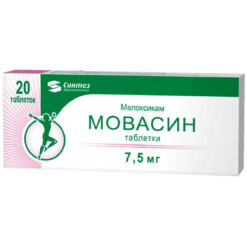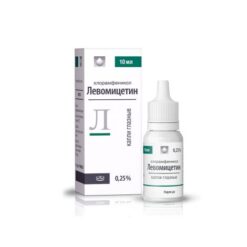-
×


-
×


Subtotal: €9.11




Subtotal: €9.11




Subtotal: €9.11
€5.64 €4.31
Pharmacodynamics
Bacteriostatic broad spectrum antibiotic, disrupts the process of protein synthesis in the microbial cell.
It is effective against strains of bacteria resistant to penicillin, tetracyclines, sulfonamides.
Active against many Gram-positive and Gram-negative bacteria, causative agents of septic infections, typhoid, dysentery, meningococcal infection, Haemophilus influenzae bacteria, Escherichia coli, Shigella dysenteria spp, Shigella flexneri spp, Shigella boydii spp, Shigella sonnei spp., Salmonella spp. (including Salmonella typhi, Salmonella paratyphi), Staphylococcus spp., Streptococcus spp. (including Streptococcus pneumoniae), Neisseria meningitidis, several strains of Proteus spp, Pseudomonas pseudomallei, Rickettsia spp., Treponema spp., Leptospira spp., Chlamydia spp. (including Chlamydia trachomatis), Coxiella burnetii, Ehrlichia canis, Bacteroides fragilis, Klebsiella pneumoniae, Haemophilus influenzae.
He acts on acid-fast bacteria (including Mycobacterium tuberculosis), Pseudomonas aeruginosa spp., clostridia, methicillin-resistant strains of staphylococci, Acinetobacter, Enterobacter, Serratia marcescens, indole-positive strains of Proteus spp.
Microbial resistance develops slowly.
Pharmacokinetics
Absorption – 90% (fast and almost complete). Bioavailability – 80%. Binding to plasma proteins – 50-60%, in premature infants – 32%. Tmax after oral administration is 1-3 hours. Vd – 0.6-1 l/kg. Therapeutic concentration in blood is maintained for 4-5 hours after intake.
It penetrates well into body fluids and tissues. The highest concentrations are formed in the liver and kidneys. Up to 30% of the administered dose is found in bile. Cmax in cerebrospinal fluid is determined 4-5 hours after a single oral administration and can reach 21-50% of Cmax in plasma and 45-89% in inflamed cerebrospinal fluid. Passes through the placental barrier, fetal serum concentrations may be 30-80% of maternal blood concentrations. Passes into breast milk. The main amount (90%) is metabolized in the liver. In the intestine under the influence of intestinal bacteria it is hydrolyzed with the formation of inactive metabolites. </It is eliminated during 24 hours, by kidneys – 90% (by glomerular filtration – 5-10% unchanged, by tubular secretion as inactive metabolites – 80%), through the intestines – 1-3%. T1/2 in adults is 1.5-3.5 hours, in patients with impaired renal function – 3-11 hours. T1/2 in children (from 1 month to 16 years) is 3-6.5 hours, in newborns (from 1 to 2 days) – 24 hours or more (varies especially in children with low birth weight), 10-16 days – 10 hours. Poorly amenable to hemodialysis.
Diseases caused by sensitive microorganisms:
– brain abscess;
– typhoid fever;
– paratyphoid;
– salmonellosis (mainly generalized forms);
– dysentery;
– brucellosis;
– tularemia;
– Q fever;
– meningococcal infection;
– rickettsioses (including typhus, trachoma, Rocky Mountain spotted fever);
– psittacosis;
– inguinal lymphogranuloma;
– chlamydia;
– yersiniosis;
– ehrlichiosis;
– urinary tract infections;
– purulent wound infection;
– pneumonia;
– purulent peritonitis;
– biliary tract infections;
– purulent otitis media.
Pharmacological action – broad spectrum antibacterial.
Pharmacodynamics
A broad-spectrum bacteriostatic antibiotic that disrupts the process of protein synthesis in the microbial cell.
Effective against strains of bacteria resistant to penicillin, tetracyclines, and sulfonamides.
Active against many gram-positive and gram-negative bacteria, pathogens of purulent infections, typhoid fever, dysentery, meningococcal infection, hemophilic bacteria, Escherichia coli, Shigella dysenteria spp., Shigella flexneri spp., Shigella boydii spp., Shigella sonnei spp., Salmonella spp. (including Salmonella typhi, Salmonella paratyphi), Staphylococcus spp., Streptococcus spp. (including Streptococcus pneumoniae), Neisseria meningitidis, a number of strains of Proteus spp., Pseudomonas pseudomallei, Rickettsia spp., Treponema spp., Leptospira spp., Chlamydia spp. (including Chlamydia trachomatis), Coxiella burnetii, Ehrlichia canis, Bacteroides fragilis, Klebsiella pneumoniae, Haemophilus influenzae.
Does not affect acid-fast bacteria (including Mycobacterium tuberculosis), Pseudomonas aeruginosa, Clostridia, methicillin-resistant strains of staphylococci, Acinetobacter, Enterobacter, Serratia marcescens, indole-positive strains of Proteus spp., Pseudomonas aeruginosa spp., protozoa and fungi.
Microbial resistance develops slowly.
Pharmacokinetics
Absorption – 90% (fast and almost complete). Bioavailability – 80%. Communication with plasma proteins is 50–60%, in premature newborns – 32%. Tmax after oral administration – 1-3 hours. Vd – 0.6-1 l/kg. Therapeutic concentration in the blood remains for 4–5 hours after administration.
Penetrates well into body fluids and tissues. The highest concentrations are created in the liver and kidneys. Up to 30% of the administered dose is found in bile. Cmax in the cerebrospinal fluid is determined 4–5 hours after a single oral administration and can reach 21–50% of Cmax in plasma for non-inflamed meninges and 45–89% for inflamed meninges. Passes through the placental barrier, concentrations in the fetal blood serum can be 30–80% of the concentration in the maternal blood. Passes into breast milk. The main amount (90%) is metabolized in the liver. In the intestine, under the influence of intestinal bacteria, it is hydrolyzed to form inactive metabolites.
It is excreted within 24 hours, by the kidneys – 90% (by glomerular filtration – 5-10% unchanged, by tubular secretion in the form of inactive metabolites – 80%), through the intestines – 1-3%. T1/2 in adults – 1.5-3.5 hours, with impaired renal function – 3-11 hours. T1/2 in children (from 1 month to 16 years) – 3-6.5 hours, in newborns (from 1 to 2 days) – 24 hours or more (varies especially in children with low birth weight), 10-16 days – 10 hours. Weakly susceptible to hemodialysis.
Due to high toxicity, it is not recommended to be used unnecessarily for the treatment and prevention of common infections, colds, flu, pharyngitis, and bacterial carriage.
Severe complications from the hematopoietic system are usually associated with the use of high doses (more than 4 g/day) for a long time.
During treatment, systematic monitoring of peripheral blood patterns is necessary.
In the fetus and newborns, the liver is not developed enough to bind chloramphenicol, and the drug can accumulate in toxic concentrations and lead to the development of gray syndrome, so in children in the first months of life the drug is prescribed only for health reasons.
When taking chloramphenicol and ethanol simultaneously, a disulfiram reaction may develop (skin hyperemia, tachycardia, nausea, vomiting, reflex cough, convulsions).
Chloramphenicol
Active substance: chloramphenicol 500 mg
Excipients: potato starch; Low molecular weight medical PVP (povidone); calcium stearate.
– hypersensitivity;
– inhibition of bone marrow hematopoiesis;
– acute intermittent porphyria;
– deficiency of glucose-6-phosphate dehydrogenase;
– liver failure;
– renal failure;
– skin diseases (psoriasis, eczema, fungal infections);
– pregnancy;
– lactation period;
– children’s age (up to 2 years).
Prescribe with caution to patients who have previously received treatment with cytotoxic drugs or radiation therapy.
From the digestive system: dyspepsia, nausea, vomiting (the likelihood of development is reduced when taken 1 hour after a meal), diarrhea, irritation of the oral mucosa and pharynx, dermatitis (including perianal dermatitis – when used rectally), dysbacteriosis (suppression of normal microflora).
From the hematopoietic organs: reticulocytopenia, leukopenia, granulocytopenia, thrombocytopenia, erythrocytopenia; rarely – aplastic anemia, agranulocytosis.
From the nervous system: psychomotor disorders, depression, confusion, peripheral neuritis, optic neuritis, visual and auditory hallucinations, decreased visual and hearing acuity, headache.
Allergic reactions: skin rash, angioedema.
Other: secondary fungal infection, collapse (in children under 1 year).
Simultaneous administration with drugs that inhibit hematopoiesis (sulfonamides, cytostatics), affecting metabolism in the liver, as well as with radiation therapy, increases the risk of side effects.
When taking ethanol simultaneously, a disulfiram reaction may develop.
When prescribed with oral hypoglycemic drugs, their effect is enhanced (by suppressing metabolism in the liver and increasing their concentration in plasma).
When used simultaneously with erythromycin, clindamycin, lincomycin, a mutual weakening of the effect is observed due to the fact that chloramphenicol can displace these drugs from the bound state or prevent their binding to the 50S subunit of bacterial ribosomes.
Reduces the antibacterial effect of penicillins and cephalosporins.
Chloramphenicol suppresses the cytochrome P450 enzyme system, therefore, when used simultaneously with phenobarbital, phenytoin, and indirect anticoagulants, there is a weakening of the metabolism of these drugs, a slower elimination and an increase in their concentration in plasma.
Gray syndrome may occur in premature infants and newborns when treated with high doses, the development of which is caused by the accumulation of chloramphenicol due to the immaturity of liver enzymes in children, as well as its direct toxic effect on the myocardium.
Symptoms: bluish-gray skin color, low body temperature, irregular breathing, lack of reactions, cardiovascular failure. Mortality – up to 40%.
Treatment: hemosorption, symptomatic therapy.
List B. In a place protected from light, at a temperature not exceeding 25 ° C. Keep out of the reach of children.
5 years
Dalkhimfarm, Russia
| Shelf life | 5 years |
|---|---|
| Conditions of storage | List B. Keep in a light-protected place at the temperature not more than 25 °С. Keep out of reach of children. |
| Manufacturer | Dalkhimpharm, Russia |
| Medication form | pills |
| Brand | Dalkhimpharm |
Buy Levomycetin, tablets 500 mg 20 pcs with delivery to USA, UK, Europe and over 120 other countries.